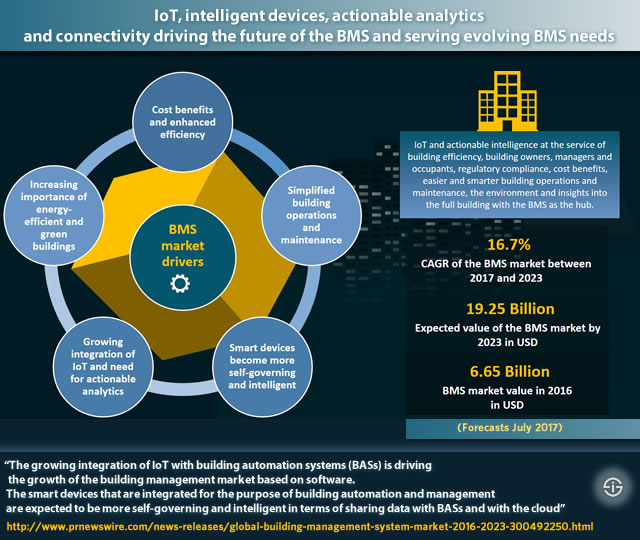The building management systems market is not just in full flux, it’s also looking at pretty healthy growth until at least 2023. The drivers of the market and those of the growing focus on the integrated building management system as a digital hub of connectivity in buildings partially overlap.
Especially the increasing integration of the Internet of Things (IoT) and IoT in building management or building automation systems (BASs), as BMSs are also called, make building automation systems the center of connectivity in a market that is increasingly adopting IoT and will continue to be strongly influenced by IoT.
This is the case for the building management systems market as such, in building management as a practice and in all the evolutions with regards to buildings, whether it concerns power management in critical power buildings, light and room control where IoT is also changing the game, the more traditional domains of full-fledged integrated building management systems (HVAC, lighting and access control being just a few BMS areas which already cover a broad range of building controls and services), in building energy management systems (BEMS) and in the smaller building management systems as they are increasingly used in smaller and medium buildings, in a non-residential and even high-end residential market of advanced home automation where we move towards more and more, nearly limitless, home automation applications with IoT.

The BMS market: poised to grow at a CAGR of over 16.7 percent between 2017 and 2023 – the data and the drivers
We’ve tackled the role of IoT in building management and building management systems before where we also looked at some other drivers of the market. Research announced in the Summer of 2017, confirms the role of IoT and several of the other drivers we mentioned in the global building management systems market.
According to the announcement of the BMS research, which looks at the BMS market by software, the BMS market is expected to grow at a double-digit CAGR (Compound Annual Growth Rate) of over 16.7 percent between 2017 and 2023. That would mean a total of USD 19.25 billion by 2023 for the BMS market with its various players (the report looks at 11 of them).
By way of comparison: in 2016 the building management system market was valued at USD 6.65 billion (industrial, commercial, and residential users).
Looking at the major drivers of the BMS market, we note:
- The eternal but nonetheless crucial importance of cost savings and optimization, which goes hand in hand with several other drivers.
- Simplified building operations and maintenance, not a luxury in today’s increasingly connected reality with demanding regulators, building owners and occupants.
- A growing demand for energy-efficient and eco-friendly buildings which, as Martin Feder of Schneider Electric (one of the 11 companies the report looks at) and his colleagues in the EcoXpert program of the company reminded us, isn’t just function of increasing regulation but also of cost avoidance because of regulatory taxation systems in some countries, a growing awareness around ecology and…peer pressure.
- The mentioned growing integration of IoT, on which we expand in the scope of both the research and the links with other technologies and evolutions next.
The BMS market and technologies: from IoT and cloud to data analytics and AI/cognitive
This growing integration of IoT with building automation systems is also impacting the software part of the BMS market (which by the way also includes hardware, services and communications to name a few on top of the software solutions which are analyzed in the report).
Moreover, in today’s increasingly IoT-enabled integrated building management market, it is to be expected that smart devices which get integrated for building automation and management will become more self-governing and intelligent (read: autonomously taking decisions and reporting the what and why of these decisions to the central system) with regards to data sharing with building automation systems and with the cloud.
This entirely corresponds with the evolutions as they are mentioned in our BMS evolutions overview and the mentioned interviews we had with regards to building management (systems) and IoT but also interviews on lighting and room control and the IoT, connected power for smaller buildings and IoT and critical power buildings and IoT, to name a few – and how else could it be in a converging reality as the IoT and IP are causing?
Moreover, it’s of course not just about IoT. When we talk about data sharing and cloud we inevitably also talk about analytics, whereby the move of field controllers to the IP level and, next autonomous decision making at the field level is further increasing connectivity in building management according to Martin Feder.
And in that scope, where we see autonomous decisions being taken across building elements we’re exactly seeing the same evolutions in the BMS market as in other markets where artificial intelligence and advanced analytics will be applied as we move to the next stage and critical data and insights are entering the BMS visualization system.
Obviously there are also challenges with regards to the BMS market. We note a lack of technically skilled workers, high initial implementation costs and more.
Check out the announcement of the research for more information on these challenges and findings from the report, which you can get here.

Top image: Shutterstock – Copyright: garagestock – All other images are the property of their respective mentioned owners.

